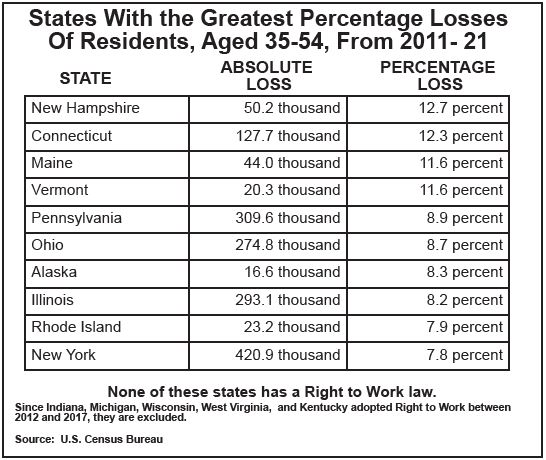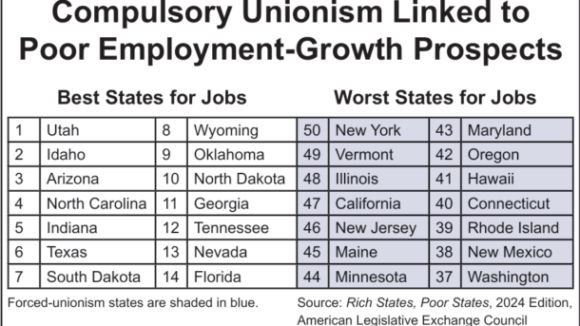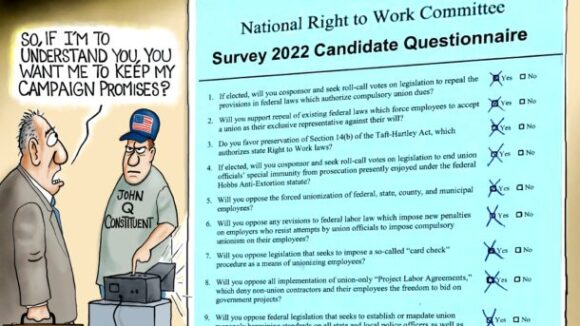Is This Any Way to Run a City’s Schools?
Leaked CTU Proposals Won’t Do Anything to Improve Schools’ Poor Performance

Census Bureau data clearly show that, when they have a choice, working-age people prefer not to live in forced-unionism states. Union spokesmen have extraordinary difficulty explaining away this unimpeachable fact.
Union bosses often grossly understate, or altogether “forget” about, regional cost-of-living differences when they are debating living standards in Right to Work states vs. in forced-unionism states.
Downplaying or ignoring this key issue makes it easier to hide the economically disastrous effects of compulsory unionism.
But no matter how vociferously Big Labor tries to insist that corralling workers into monopolistic unions somehow makes them more prosperous, there is one unimpeachable fact that union spokesmen have extraordinary difficulty explaining away: When they have a choice, working-age people prefer not to live in forced-unionism states.
Considered together, age-grouped state population data for 2021 released by the U.S. Census Bureau this June and comparable, recently revised data for 2011 tell an important story.
They show that, over the past decade, the total population of people in their peak-earning years (aged 35-54) for the 23 states that have yet to adopt and implement a Right to Work law, barring the termination of employees for refusal to bankroll an unwanted union, fell from 43.49 million to 41.67 million.
That represents a 4.2% decline.
Nationwide, the peak-earning-year population fell by 2.2% from 2011 to 2021 as a consequence of the aging of the Baby Boomers. But in the 22 states that had Right to Work laws on the books the whole time, there was an overall increase of 1.19 million!
And the correlation between forced unionism status and peak-earning-year population decline is quite robust.
Among the 45 states that didn’t change their Right to Work status over the past decade, the 10 states experiencing the most severe peak-earning-year losses in percentage terms are all forced-unionism. (See the chart below.)
Meanwhile, the four top-ranking states are all Right to Work.
Had the decline in the 23 states that still don’t have Right to Work laws today been only as severe as the national average, they would have had roughly 850,000 more residents in their peak-earning years as of 2021.
From July 2020 to July 2021, the last year for which age-grouped state population data are available, the trend of “foot voting” against forced unionism by people who have families to support got even stronger.
Census figures indicate forced-dues states lost nearly 200,000 “peak earners” to domestic out-migration over this one-year period. If this trend continues, these states are poised to lose another net two million breadwinners to Right to Work states from 2020-30!
National Right to Work Committee Vice President Matthew Leen commented:
“The obvious and correct explanation for this accelerating population shift is that breadwinners, along with their families, are fleeing forced-dues states in droves.
“Working men and women find again and again that they cannot provide as well for their families in such states as they can in Right to Work states, with their generally higher real incomes.”
Mr. Leen pointed to a 2020 analysis by the National Institute for Labor Relations Research, which showed that the mean after-tax, cost of living-adjusted household income in 2019 was roughly $4,300 higher in Right to Work states than in forced-unionism states.
Mr. Leen emphasized that the Institute’s findings should surprise no one who is familiar with the data revealing where America’s breadwinners prefer to work and live. He explained:
“It defies common sense to claim that people who get the vast majority of their income from their jobs would lopsidedly favor living in states where they are worse off over states where they are better off.
“Yet that’s effectively what Big Labor propagandists do claim, again and again.
“The fact is, people choosing where to live know their decisions have real consequences, and therefore they generally don’t act without first considering all the key facts.
“That’s why we should trust ‘foot voters’ to know what’s best for their families. And they are telling us that they are better off in Right to Work states than in forced-unionism states.”
This article was originally published in our monthly newsletter. Go here to access previous newsletter posts.
To support our cause and help end forced unionism, go here to donate.

Leaked CTU Proposals Won’t Do Anything to Improve Schools’ Poor Performance

Wherever Big Labor wields the power to collect forced union dues, union bosses funnel a large share of the confiscated money into efforts to elect and reelect business-bashing politicians. Employment growth tends to lag as a consequence.

Members Insist They Keep Pro-Right to Work Campaign Promises